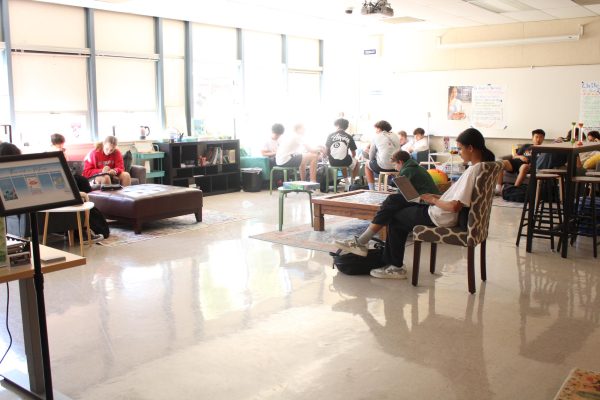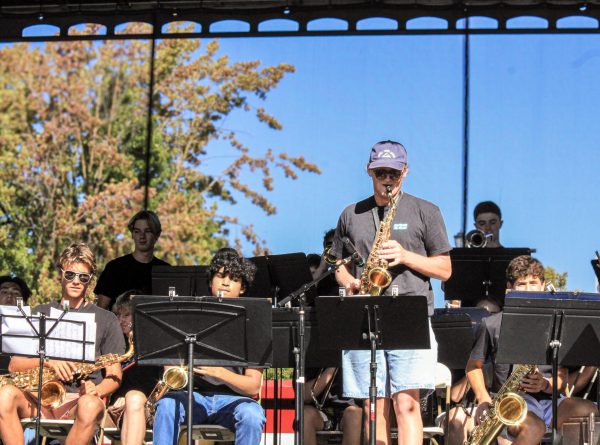Challenge Success Survey Reveals Exceptional Stress
Campolindo is no stranger to high scores. Its students achieved among the highest California Assessment of Student Performance and Progress (CAASPP) scores in the state. Its athletic program was ranked the best in the state for Division III sports, according to Cal-Hi Sports.
Now, Campolindo can officially add one more achievement to its long list: student anxiety scores.
According to results from the Stanford Survey of Adolescent Student Experiences, which was administered to 1100 Cougars in April 2015, Campolindo’s students experience extremely high levels of anxiety. Principal John Walker said that the “high levels of academic stress” are a concern for more than just the students. It is an issue that the “community should address.”
Specifically, 83% of students said they “often or always” felt stressed about schoolwork.
Walker cautioned that “stress is a complicated metric. One person’s stress is another person’s energizing activity. So it’s difficult to measure.” However, he still said he found the results “concerning”.
“We want schoolwork to be engaging, and challenging, and rigorous, but we don’t want it to create unhealthy stress. We don’t believe schoolwork should be simple, basic, rote – we want it to be challenging, engaging, and rigorous, but we don’t want it to cause stress,” Walker said. “So we’re concerned that our students are feeling stressed. Is it stress about how long it takes? Is it stress about doing well? If it is stress about it doing well, are those pressures internal, or are those pressures from their parents? Or both?”
However the data is “interpreted,” it is hard to avoid the conclusion that Campolindo students are stressed.
“I feel like there’s definitely high stress, just because it’s such a competitive school and everyone really wants to do well,” senior Leadership student Katie Erickson said.
“We had a lot of anecdotal evidence that our students were feeling stressed that was coming from the counseling department, my parent meetings that I have regularly throughout the year, and our conversations with students,” Walker added.
“So we were receiving all of this anecdotal evidence that our students were feeling stressed, so we thought, ‘You know what? Let’s give a formal survey.’ And the best survey we knew about was from Challenge Success. So we decided to partner with them,” he explained.
Challenge Success, the organization that administers the survey as well as debriefs its results and advocates for a reduction in stress and academic pressure in high schools, was particularly concerned about the spring data from Campolindo. Teacher Jamie Donohoe, who attended a fall staff meeting where the data was discussed, said that Walker had told his audience “that they [Challenge Success] were just shocked at the level of stress – they hadn’t seen results like these.”
“It’s very disturbing,” Donohoe said of the survey results.
Even in comparison to schools with similar demographics situated in similar communities, Campolindo’s student stress scores are extremely high. “On the spectrum of most relaxed on one end; on the other end of the spectrum, where there’s a tremendous amount of stress, unfortunately, we’re closer on the end of the spectrum where there’s high levels of student stress,” said Walker.
In addition to student stress levels, the survey gathered data on student engagement, how students spend their time, and academic honesty.
According to survey results, cheating is widespread at Campolindo. 80% of students reported that in the last year, they had copied homework. 35% reported copying answers during a test, and 23% reported using a false excuse to get out of an exam or due date.
Walker was concerned about the cheating results. He said, “We want students’ work to reflect their own thoughts, their own skills. If it’s collaborative work, we want it to reflect the work of that group. It’s misleading when students are getting answers from an unauthorized source. We’re not sure who they are, their skill level in terms of what they really know. We believe integrity is an important value and one we want to promote and foster. We’re going to closely examine the link between academic integrity and the amount of stress students feel.”
Walker and Challenge Success believe low academic integrity and high stress levels are linked. “Challenge Success literature that we’ve been provided suggests as much. Actually, stronger word, it doesn’t suggest, they document that there are high levels of stress to perform well – unhealthy stress to perform well – there’s a direct correlation with academic honesty issues. So, we want to investigate that,” Walker said.
The survey also found that Campolindo students get, on average, between 6-7 hours of sleep, which is below the 9-10 hours recommended by pediatricians.
These results line up with results from a survey that Donohoe sent to recent graduates about sleep and academic achievement. “I just did it coming on the heels of Challenge Success and conversations with other teachers. I wanted to see if what my students said specifically about their sleeping, if it matched up with what Challenge Success said,” Donohoe explained.
Donohoe received about 80 responses – a much smaller sample size than in the Challenge Success survey – but he noticed that there was a trend – on average, more recent graduates received less sleep while attending Campolindo than students who graduated from earlier years, like in 2009.
Current Campolindo students also spend more than 3 hours on homework, on average, every day, which Walker also found “concerning”. “Because on top of that, the vast majority of our students are involved in extracurricular activities, so you can see we’re quickly running out of hours in the day. Lack of sleep, heavy homework load, pressures from extracurricular activities, these are all the things that can contribute to stress,” Walker explained.
Students at the other 3 comprehensive high schools in the Acalanes Union High School District (AUHSD) also took the survey, and all revealed high levels of student stress.
“There’s levels of stress at all 4 high schools that need to be addressed, and strategies need to be implemented to try to reduce those levels of stress. But every school has slightly different data,” Walker said. He hasn’t looked at the data from other schools, but said, “I know that our levels of homework and hours of sleep are very concerning in comparison to the others.”
“So some of the data from the report is concerning,” Walker said. “Very concerning.”
The recent survey’s results have caught the attention of many teachers and administrators, but it is not the first time the issues of stress and academic integrity have been addressed on campus.
About 2 years ago, Donohoe administered his own survey to his seniors. Like Challenge Success, Donohoe found a high rate of cheating. “My wife [counselor Jake Donohoe] and I put together some questions that I gave to my seniors. They were going out so I figured they’d be honest about it. And then we made that accessible to some other teachers,” Donohoe said. “And I know some other teachers did it with their classes and we collected all that data, and there was an in service day in which a lot of us got together, looked at the data, and just talked about it, and tried to come up with solutions to the problem of the high rate of cheating at Campo.”
Donohoe said that after seeing the results of his survey, teachers “mostly looked at what they were doing with their testing to make it more difficult to cheat.”
Additionally, Campolindo has partnered with the Challenge Success program independent of the other district schools in the 2011-12 school year. According to teacher Carol Paymer, who was a point person for the previous collaboration with the Stanford program, the partnership occurred for the “same reasons as now, only it’s probably worse now. Just student stress, seeing if there’s anything we can do in our jobs to make life better.”
In 2011-12, students did not take a survey. Instead, a “large” group of staff members went to a conference about stress at Stanford University. Challenge Success also sent a representative to the staff’s monthly meetings who was “kind of supposed to be supporting us in the process;” however, Paymer said that the representative did “nothing”.
Now however, Paymer believes actions will be taken to successfully reduce student stress levels. “I didn’t feel like it had any lasting impact, but I feel like this time, it’s not just our school, it’s our whole district, and it seems to have a lot more support behind it, so I’m hopeful that this time we will have more success,” Paymer said.
She added, “I think Challenge Success has changed their approach quite a bit. I did not find that they were very helpful to us 5 years ago. So I’m hopeful that it already sounds like with the survey they’re being more active in our process rather than just sort of being passive observers, which was how I felt last time.”
This year, steps are being taken on administrative and faculty levels to address the results of the survey, specifically the high levels of stress.
Walker has assembled a special team to deal with the results of the survey and come up with ideas to address student stress. The team includes counselor Jenna Wrobel, teachers Kristen Michael and Ryan Boyd, students Erickson and Fiona Stewart, parents Carol Spiering and Shari Simon, and Walker.
First, the team of 8 will attend a conference hosted by Challenge Success at Stanford University on September 25 and 26.
“We’re going to review the data in more detail, and start to discuss strategies to help reduce unhealthy levels of stress. So we’re going to talk about student engagement, we’re going to talk about strategies for parents to help at home,” Walker said. “They [Challenge Success] won’t give us a A-Z program to reduce stress. They will give us ideas and suggestions and help us make it their own. ‘Cause every school is unique.”
Representatives from other schools both inside and outside of the AUHSD will also be attending the conference.
“We’re absolutely going to do individual school [strategies to reduce stress], because every school is slightly different,” Walker said. “But I think we’re going to at least investigate potential district-wide strategies. ‘Cause the 4 high schools have some similar data.”
After the conference, the Challenge Success team will bring the ideas back to the Campolindo Instructional Council, which is a leadership body at the school comprised of teachers and administration, according to Walker. They will also share the ideas with the school site council, which is a leadership group comprised of students, parents, and staff. These meetings will take place in October. Then, “we would like to start implementing specific strategies this year, so at the beginning of second semester,” Walker said.
While specific strategies will be discussed at the conference, Walker has already begun thinking about possible ways to address the high levels of student stress.
He believes high achievement and high levels of stress can be correlated, but that they don’t have to be. The ideal balance between the two would be high achievement and low stress, but such a balance would not be easy to maintain.
“I do think it’s possible, but I think it’s something that you would have to continuously work on as an educator. We’d have to continuously work with our students and with our parent community. There’s no magic bullet to achieving high levels of academic success and ensuring that there’s low levels of stress – it’s a complicated relationship to maintain,” he said. “But whether it’s complicated or not, we need to pursue that kind of environment. Because we want our students to demonstrate great achievement academically, and for different students that will look differently, but we do not want our students to feel unhealthy levels of stress.”
Some ideas Walker is considering include reducing homework to allow students to live “a balanced life”, spreading out tests throughout the week, providing additional tutoring and academic support, encouraging students to stay focused and away from music, social media, and television/YouTube while doing homework, and promoting “appropriate healthy expectations about college and career, to recognize that there are an infinite amount of options of great post-high school opportunities, ranging from four year college to a gap year, to community college, to military service, to technical training, or for some students, straight to the work world. We want them to recognize the broad array of options, rather than narrowly focus on one option – the end all, be all option.”
Walker is not certain how this will all be achieved, but points out that teacher-led tutoring sponsored by the Moraga Education Foundation (MEF) and the Campolindo Parents’ Club is currently available. Walker thinks the school might want to expand or adjust the times tutoring is offered. Right now, tutoring is offered after school, “but so many of our students are involved with after-school activities that they can’t necessarily access it when they need to,” Walker said.
“So we’ve explored lunchtime tutoring, although I’m concerned about that because students need a break in the day when they can sit and eat and relax with their friends. We’ve considered before school tutoring, which can be a good option for many students,” Walker said. He admits that student sleep is also a problem, so asking students to arrive earlier has its own negative impact.
“It’s complicated,” Walker said.
So far, Walker has focused on raising awareness of the survey’s results among staff. A Campolindo faculty meeting and district-wide meetings have been held in response to the survey data.
At the staff meeting, Walker said that “the survey data generated some very good discussion and recognition that these are complex problems, and there’s no easy solution.”
According to Walker, the staff spent a lot of time discussing homework. He said, “It was a topic the staff was very interested in, in part because parents, students, and staff have some direct control over how homework is handled and approached.”
“So we as staff assign it. Students make choices about when to do it, how to do it, to listen to music, to be on Facebook or not – well, you don’t use Facebook any more – to be on social media or not? Students have some control over homework. Parents also do, in terms of what kind of environment they set up at home – what are their family protocols about homework and how is that enforced? We all have a hand in how homework is played out in the afternoon and evening,” Walker said. “And so that seemed like an area of focus where we could have some small positive impact.”
“Regarding homework, the amount of time spent on completing homework and what students reported doing in conjunction with doing their homework. So, for example, and these are not judgements, these are what people reported: 42% of students reported talking and texting on the phone regularly while they did homework. 64% reported listening to music while doing homework,” Walker said.
He added, “I’m not sure of the impact of listening to music while doing homework, but I think a lot of it would depend on the student. But I think we should, as staff and students – we should look at that for our students to make sure that homework time is set up to be most productive, so we don’t have to spend an excessive amount of hours doing homework.”
Walker said that teachers made suggestions about the homework issue, but that they “didn’t make decisions.” “We didn’t rank suggestions. It was raising awareness and sort of reflections,” he added.
“We are still in the process of getting some common ground regarding homework,” Walker said.
At the September 18 staff development, time was provided for faculty and administrators to again discuss the survey data.
According to Paymer, who attended the September 18 meetings, one meeting was led by Superintendent John Nickerson about Challenge Success and district survey results in general, and another was facilitated by Walker about homework.
Nickerson presented key statistics from the survey and “talked about the support the district has for this process, which was really good to hear,” Paymer said.
As for Walker’s meeting, Paymer said, “It’s a difficult topic, homework. So this was just the beginning of the discussion. Lots of people have been doing it the same way for a long time, and it’s hard to step back and think, ‘Can I be doing this differently?’ So talking about it in groups is a really positive step.”
“I think we all have a tendency to assume that everyone agrees with us, [a] tendency to think own viewpoint is shared sometimes on a larger scale than it is,” Paymer said. “So hearing other people disagree is enlightening. For example, the average amount of time spent on homework per night, some people think it’s too much, other people think it’s just fine. And we need to kind of come to an agreement on that so we can move on.”
Still, Paymer said she “felt that the entire staff development day on Friday was very positive and a good start.”
Walker said that results will not be shared with the broader community until after the conference. He explained, “Because it’s such an extensive survey, I want to sit down with those who designed it and go through it with them, and make sure we have a full, accurate comprehension of what the data is demonstrating.”
However, some teachers have already responded to the results by altering their instructional habits, and some students are seeing changes for the better.
New English teacher Erin Cody said that when she arrived on campus for the first time in the fall, she was surprised at how involved students were in extracurricular activities and athletics. The level of student motivation and amount of structured time is high relative to her previous school.
“I think it’s great, and I also worry too. I worry that they’re stretched too thin. I think it’s really neat that they’re so involved in their community, and so involved with their extracurricular activities, and with Campo athletics and everything else that Campo provides. And at the same time, I wonder, I know how much homework they’re getting too. I worry, ‘What are those stresses like?’ I know that you guys are stressed out and feeling the pressure of everything, so that concerns me as well,” Cody said.
On an individual level, some teachers are also being mindful of the survey’s results when they assign work.
Cody said that she tries to make sure that “what I assign outside of the classroom is pertinent and not wasting my students’ time.”
“My goal is within a year, to have zero homework,” Donohoe said. “I don’t know if I’ll achieve that goal – certainly haven’t yet – but that’s my goal, is to bring a lot of that homework time into class.”
Some students have noticed a change.
“I think teachers are a lot more conscious about it now. I feel like a lot of my teachers this year are like, ‘I know you’re really stressed out, so I won’t give you guys as much homework.’ Which is nice,” Stewart said. “Teachers are starting to give less busy work, more meaningful work. We just work harder in class so we don’t have homework to do at home.”
Still, the issue has not yet been resolved. Donohoe frequently hears from graduates that Campolindo is harder than college. He said, “I’ve heard that for a long time, and I’ve taken it with a sense of pride, that we prepare our students so well that college is a breeze for a lot of them. I’m doing an about face and realizing that I’ve been a part of a systemic problem. Why can’t high school just be high school, and then you’re prepared enough, and then you go to college and you’re taken the rest of the way?” he said.
“Why is there this need to – why do we have a sense of pride that we’re working our kids so that they’re sleeping only 6 hours a night and putting them through this grinder, to then get to college, where they can have this sort of breath of relief,” he added. “There’s a problem with that.”
Your donation will support the student journalists of Campolindo High School's The Claw. Your contribution will allow us to produce more issues and cover our annual website hosting costs.

Senior and La Puma editor-in-chief Kelly Pien is a fourth-year Journalism veteran. Outside of school she enjoys reading, writing, practicing jujitsu, and...



